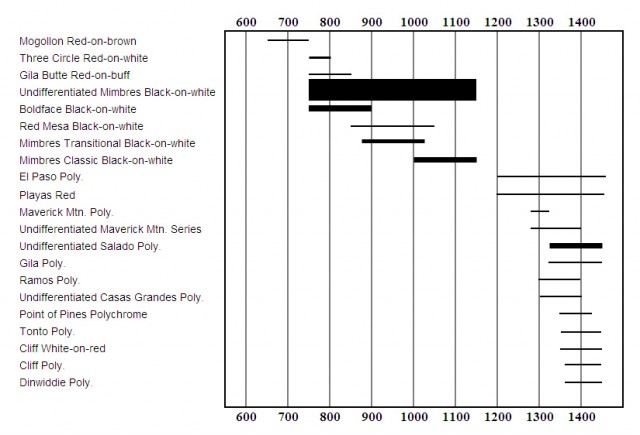- Home
- >
- Preservation Archaeology Blog
- >
- The Sherds of Gamalstad: Ceramic Chronology in Mul...
 |
By Katherine A. Dungan, Research Assistant
|
In a post back in October, I discussed the Late Pithouse period at Gamalstad, one of the sites we investigated during the 2009 field season. As I wrote then, we have evidence of a substantial pithouse occupation (c. A.D. 550–1000), underneath smaller Mimbres pueblo (that is, Mimbres Classic Phase, c. A.D. 1000–1150) and Salado (that is, Cliff Phase, c. A.D. 1325–1450) settlements.
Although we have a few traces of architecture at Gamalstad, almost all of our information about when people were living at the site comes from the pottery we collected during our excavations and from the surface of the site. Deb wrote more generally about the importance of pottery for dating sites in this post. What I want to do here is to give you an idea of the chronological picture provided by the Gamalstad ceramics.
This graph shows date ranges for decorated ceramic types recovered from Gamalstad. Though not everyone might agree on the exact production date ranges for all of these types, the general position of the types in time is widely accepted. Some types have longer production ranges than others, making them somewhat less useful for dating sites; El Paso Polychrome, for example, was produced for more than two centuries.

The width of the bars is scaled by the number of sherds of a particular type in the Gamalstad assemblage. In this case, the largest number of sherds (the actual count is 163) falls into the category “Undifferentiated Mimbres Black-on-white,” meaning that they are certainly Mimbres Black-on-white sherds but that they cannot be identified as specifically Boldface, Transitional, or Classic (also called Mimbres Black-on-white Styles I, II, and III). There are often small sherds with little or no surviving painted design, although I admit that an analyst with more Mimbres expertise probably could have classified more of these than I was able to. The thinnest lines represent types for which 10 or fewer sherds were recovered from Gamalstad.
The decorated ceramic counts alone don’t necessarily tell us much about the number of people living at the site at any one time. For example, a small pithouse settlement occupied through the entire Late Pithouse phase might produce the same volume of ceramics as a large settlement occupied for a shorter time span. But the comparatively small proportion of Salado polychromes (which in this list include Gila, Tonto, Cliff, and Dinwiddie Polychromes), combined with the limited evidence for Cliff Phase adobe room blocks, does suggest that the Cliff Phase or Salado occupation was on the small side.
Also interesting is the likely gap in occupation between roughly A.D. 1150 and 1300 (while El Paso Polychrome and Playas Red Incised were produced beginning around A.D. 1200, their long date ranges mean that they could easily be associated with the Salado occupation of the site). Both of the other sites we have studied in Mule Creek (3-Up and Fornholt) have components dating to the 1200s. Nevertheless, Gamalstad may be more typical of sites across the Upper Gila: although a large number of pithouse, Classic Mimbres, and Cliff Phase sites have been recorded and studied in the Upper Gila, settlements dating to the 1200s seem to be much less common. Just how the apparently thin population in the Upper Gila during the 1200s is related to the settlements in Mule Creek is something that I hope my long-term research will help illuminate.
Explore the News
-
Join Today
Keep up with the latest discoveries in southwestern archaeology. Join today, and receive Archaeology Southwest Magazine, among other member benefits.